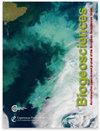土壤-可生物降解塑料薄膜在湖泊沉积物中孵育9个月以上不会分解
IF 3.9
2区 地球科学
Q1 ECOLOGY
引用次数: 1
摘要
摘要农业在很大程度上依赖于塑料地膜的使用,这种地膜可以提高作物产量,降低对水的需求。近年来,土壤可生物降解地膜已被推向市场,以取代不可生物降解的传统聚乙烯基地膜。这些可生物降解的地膜被设计成在使用后犁入土壤中,由土壤微生物在原位进行生物降解。然而,研究表明,部分地膜材料可能从田间转移到邻近环境,包括水生生态系统。目前缺乏对淡水生境中土壤生物降解塑料的潜在生物降解研究。在此,我们研究了瑞士卢塞恩湖淡水湖沉积物中土壤-可生物降解农业地膜的矿化。两种类型的商业土壤可生物降解地膜与传统的聚乙烯(PE)塑料一起在湖泊沉积物核心中孵育,并相对于不含塑料的对照沉积物长期跟踪CO2和CH4的产生。经过40周的潜伏期,片子在视觉上完好无损,没有矿化迹象。气体分析表明,与对照组或PE塑料培养皿相比,可降解地膜培养皿中没有产生额外的CO2或CH4。我们认为,这两种土壤生物可降解地膜在湖泊沉积物中的生物降解性较低,可能反映了湖泊沉积物中微生物群落结构缺乏活性微生物降解剂。我们的研究结果强调了防止土壤-可生物降解地膜从农业土壤转移到周围水生环境的重要性。本文章由计算机程序翻译,如有差异,请以英文原文为准。
Soil-biodegradable plastic films do not decompose in a lake sediment over 9 months of incubation
Abstract. Agriculture relies heavily on the use of plastic mulch films, which increase crop yields and can lower water demands. In recent years, soil-biodegradable mulch films have been marketed to replace the non-biodegradable, conventional polyethylene-based mulch films. These biodegradable mulch films are designed to be ploughed into the soil after use to be biodegraded in situ by soil microorganisms. However, research has shown that part of the mulch film material may be transported from the fields to neighboring environments, including aquatic ecosystems. Research on potential biodegradation of soil-biodegradable plastics in freshwater habitats is lacking. Here, we investigated the mineralization of soil-biodegradable agricultural mulch films in freshwater lake sediments of Lake Lucerne, Switzerland. Two types of commercial soil-biodegradable mulch films were incubated within lake sediment cores, along with traditional polyethylene (PE) plastic, and the production of CO2 and CH4 was followed over time relative to non-plastic-containing control sediments. After the 40-week incubation period, the films were visually intact and showed no signs of mineralization. Gas analyses showed no additional production of either CO2 or CH4 in the degradable mulch film incubations, compared to the control or PE plastic incubations. We conclude that these two used soil-biodegradable mulch films have a low biodegradability in lake sediments, likely reflecting that the microbial community structure in the lake sediment lacks active microbial degraders. Our results highlight the importance of preventing transport of soil-biodegradable mulch films from agricultural soils to surrounding aquatic environments.
求助全文
通过发布文献求助,成功后即可免费获取论文全文。
去求助
来源期刊

Biogeosciences
环境科学-地球科学综合
CiteScore
8.60
自引率
8.20%
发文量
258
审稿时长
4.2 months
期刊介绍:
Biogeosciences (BG) is an international scientific journal dedicated to the publication and discussion of research articles, short communications and review papers on all aspects of the interactions between the biological, chemical and physical processes in terrestrial or extraterrestrial life with the geosphere, hydrosphere and atmosphere. The objective of the journal is to cut across the boundaries of established sciences and achieve an interdisciplinary view of these interactions. Experimental, conceptual and modelling approaches are welcome.
 求助内容:
求助内容: 应助结果提醒方式:
应助结果提醒方式:


